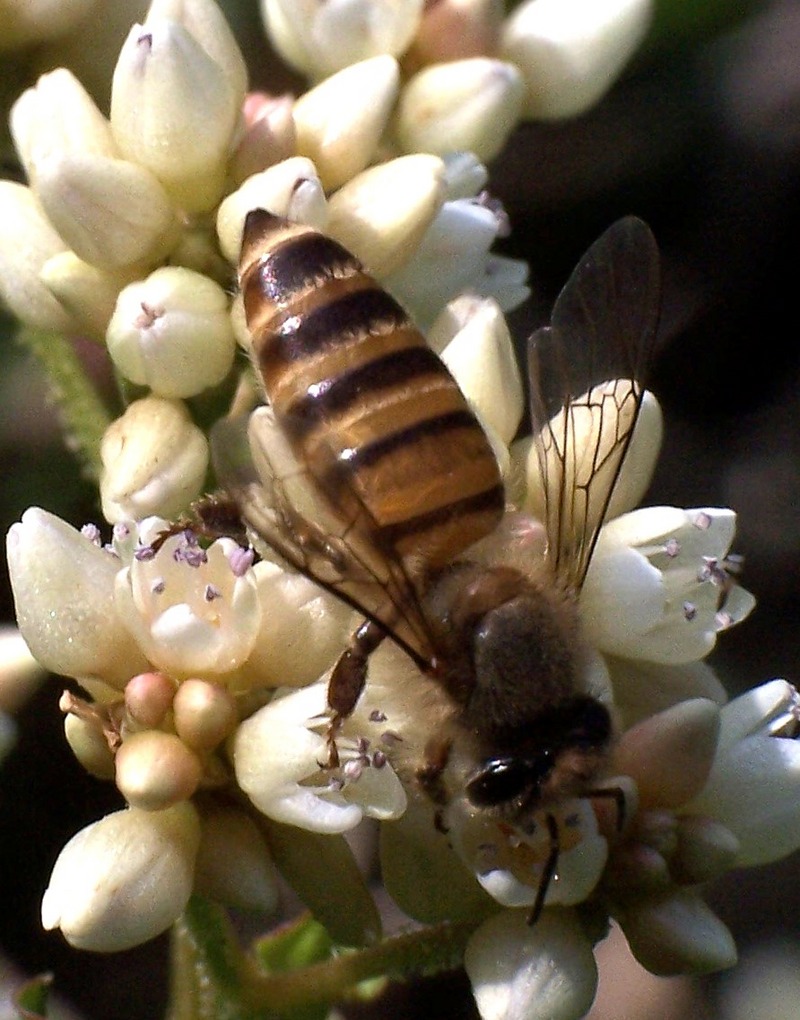Eastern Honey Bee (Apis cerana) - Wiki Apis cerana
From Wikipedia, the free encyclopedia
[Photo] Eastern Honey Bee (Apis cerana) on flower. Source: http://www.flickr.com/photos/kclama/71142008/ Author Charles Lam (http://www.flickr.com/people/kclama/)
Apis cerana, or the Asiatic honey bee (or the Eastern honey bee), are small honey bees of southern and southeastern Asia, such as China, India, Japan, Malaysia, Nepal, Bangladesh and Papua New Guinea. This species is the sister species of Apis koschevnikovi, and both are in the same subgenus as the Western (European) honey bee, Apis mellifera.
In the wild, they prefer to nest in small spaces, such as hollowed out tree trunks. Like the Western honey bee, they are sometimes domesticated and used in apiculture, mostly in wooden boxes with fixed frames. Their size is similar or somewhat smaller than Apis mellifera, and they also have a more prominent abdominal stripes. Their honey yield is smaller, because they form smaller colonies. In folk medicine, their beeswax is used to treat and heal wounds.
Apis cerana is the natural host to the mite Varroa jacobsoni and the parasite Nosema ceranae, both serious pests of the Western honey bee. Having coevolved with these parasites, A. cerana exhibits more careful grooming than A. mellifera, and thus has an effective defense mechanism against Varroa that keeps the mite from devastating colonies. Other than defensive behaviors such as these, much of their behavior and biology (at least in the wild) is very similar to that of A. mellifera.
Thermal defense: When an Apis cerana hive is invaded by the Japanese giant hornet (Vespa mandarinia), about 500 Japanese honey bees (A. cerana japonica) surround the hornet and vibrate their flight muscles until the temperature is raised to 47°C (117°F), heating the hornet to death, but keeping the temperature still under their own lethal limit (48-50°C). European honey bees (A. mellifera) lack this behavior.
Subspecies
(following Engel, 1999).
Apis cerana cerana Fabricius ( = "sinensis") - Afghanistan, Pakistan, north India, China and north Vietnam
Apis cerana heimifeng Engel
Apis cerana indica - Fabricius South India, Sri Lanka, Bangladesh, Burma, Malaysia, Indonesia and the Philippines
Apis cerana japonica Fabricius - Japan
Apis cerana javana Enderlein
Apis cerana johni Skorikov
Apis cerana nuluensis Tingek, Koeniger and Koeniger
Apis cerana skorikovi Engel ( = "himalaya") - Central and east Himalayan mountains (Ruttner, 1987)
http://en.wikipedia.org/wiki/Apis_cerana
| The text in this page is based on the copyrighted Wikipedia article shown in above URL. It is used under the GNU Free Documentation License. You may redistribute it, verbatim or modified, providing that you comply with the terms of the GFDL. |
